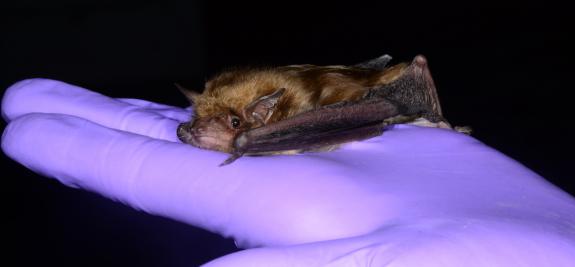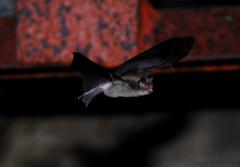Bat Project
Read about our work to help protect New Jersey's bat population.
 Big Brown Bat. ©Blaine Rothauser
Big Brown Bat. ©Blaine Rothauser
Benefits of Bats
Bats have a reputation as being spooky or even dangerous, but they are actually some of the most beneficial animals to people.
All of New Jersey's bats are insectivores. They feed on a huge variety of night-flying insects, including the beetles that devour our crops, the gypsy moths that denude our forests, and of course, those awful mosquitoes. A single little brown bat can eat 3,000 mosquito-sized insects per night! And big brown bats have even been found to eat stink bugs.
 Zoom+ Big Brown bat in flight. (c) Blaine Rothauser
Zoom+ Big Brown bat in flight. (c) Blaine Rothauser
A recent study published in Science magazine estimates that bats' insect-eating services may be worth as much as $53 billion to US agriculture alone (read about it here). Without bats, we would be more dependent on toxic pesticides to control unwanted insects.
Some garden pests can even detect the sounds that bats make while feeding and will avoid areas where bats are present. In turn, guano (bat droppings) makes for a terrific garden fertilizer!
In other areas of the world, bats play a major role in pollinating flowers and dispersing seeds for plants such as bananas, avocados, cashews, and mangoes. By dropping a wide variety of plant seeds over open areas, bats also help to restore the tropical rainforests following logging, fire, and other disturbances.
Many scientific advancements are owed to bats as well: navigational aids for the blind, blood-clot medications, artificial insemination techniques, low-temperature surgery on people, and military sonar have all been inspired by our night-flying friends.
Threats to Bats
Bats have been in decline for many years for many reasons. Some of the biggest threats include the loss of their forest habitats and roost trees, disturbance of winter dens, and outright persecution by people. Wind energy development is also raising concerns as wind farms crop up along the ridgeline corridors used by migratory bats. In the east, studies have found that an average of 46 bats are killed annually per wind turbine. Fortunately, research is showing that bat deaths can be tremendously reduced by simply shutting the turbines down during seasonal low-wind periods, when power generation is minimal anyway. Making shut-downs an operational standard should be a priority.
 Zoom+ Little brown bat with white-nose syndrome in Greeley Mine, Vermont, March 26, 2009. © Marvin Moriarty/USFWS
Zoom+ Little brown bat with white-nose syndrome in Greeley Mine, Vermont, March 26, 2009. © Marvin Moriarty/USFWS
In 2006, an aggressive new threat emerged in the form of White-nose Syndrome (WNS). The Syndrome is named for the white fungus observed first around the noses of affected bats. The fungus attacks during winter hibernation, when the bats' immune response is low, and prevents them from conserving enough stored energy to survive until spring. The fungus causes dehydration and unrest as well as severe wing damage that can prevent bats from flying. Nearly entire hibernating colonies of bats have died in its wake, and more caves and mines are impacted with each passing winter.
White-nose Syndrome was first discovered in a cave near Albany, NY, and has since spread to at least 23 eastern U.S. states and 5 Canadian provinces. The disease was confirmed in New Jersey in January 2009 and has severely depleted the state's most important hibernacula. Tens of thousands of NJ bats - and over 6 million in total - have died.
Much is still unknown about WNS and its spread, much less its consequences. The federal government, states, several universities, and private organizations are working hard to track and understand WNS. There is no evidence to suggest that WNS has any affect on humans.
Our Projects
 | Northern Long-Eared Bat Mist Netting and Radio Telemetry StudyTracking a federally listed bat species across New Jersey |
 | Bats In BuildingsInformation to help assess and address bat problems in the home. |
 | Summer Bat CountGot Bats? Help us keep tabs on New Jersey's bat populations. |
 | Acoustic Bat MonitoringHigh-tech and hands-off: New tools allow for rapid bat surveys statewide. |
 | White-Nose Syndrome ResearchA deadly fungus shifts the focus of bat conservation work. |
Learn more:
Bat Fact Sheet - 717.2KB |
>> New Jersey's NABat Mobile Acoustic Bat Survey Instructions
Find Related Info: Bats







